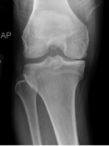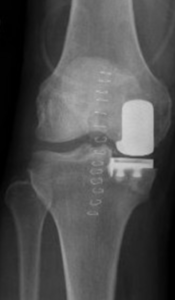Partial Knee Replacement
What is a Partial Knee Replacement?
A partial knee replacement, or known as unicompartmental knee replacement (UKA), only replaces a single compartment of the knee. The most common type of partial is a medial unicompartmental replacement, wherein only the medial (inside) portion of the knee joint is replaced. It is also possible to replace just the patellofemoral (under the kneecap) or lateral (outside) joint. Metal or ceramic and plastic components are also used for partial replacements. With a partial knee replacement, patients keep all the native ligaments of the knee (ACL, PCL, MCL, and LCL), which may allow for more rapid improvement and a more “normal” feeling knee. However, not everyone is a candidate for partial replacement. This needs to be discussed on a case-by-case basis with your surgeon.
What is Knee Osteoarthritis?
Knee Osteoarthritis, which is the most common form of arthritis. Commonly known as “wear-and-tear” arthritis, this affliction can affect active individuals who are genetically predisposed. A deterioration of the cartilage surrounding the joint surfaces can lead to painful “bone-on-bone” wear that causes pain and can keep people from participating in the activities they love.
Learn more about Knee Osteoarthritis here.
Partial vs Total Knee Replacement
For decades, the solution for patients with end stage osteoarthritis that continued to be symptomatic despite conservative treatment was a total knee replacement. Total knee replacements, or TKAs, replace the worn out joint cartilage with man-made metal and polyethylene components. The TKA is a very successful operation for restoring function and alleviating the pain of arthritis. But TKAs can wear out, and are often not the solution for younger patients who want to stay active.
Often patients who undergo a knee replacement report a self-limitation of activities because their knee doesn’t quite “feel normal.” Current versions of total knee replacements require removal of a band of tissue known as the Anterior Cruciate Ligament (ACL). The ACL is important for stability of the knee and can assist with the proprioceptive feeling of knowing where the knee is in space. Total knee replacements are also not necessarily the answer for patients who only have arthritis in one compartment of their knee. For years, patients with partial arthritis were limited to conservative care or painful realignment procedures that required cutting the bones of the leg to move them into a position to unload the arthritic portions. These surgical procedures, known as osteotomies, require activity modifications and lengthy rehabilitation protocols.
Recent advances in both surgical techniques and implant materials have led to the rise of surgical procedures known as partial knee replacements. A partial knee replacement involves an incision in the knee and a removal of the arthritic surfaces from only the areas of the knee that need replacing. The remaining compartments of the knee, as long as they have sufficient cartilage, are left in their natural state. The worn out surfaces are then replaced with metal components that are bonded to the bone using cement polymers. The joint space between the two metal components is restored with a polyethylene bearing surface that can help correct malalignment and prevent the metal components from contacting each other.
Learn more about Total Knee Replacement here.
Benefits of Partial Knee Replacement
Partial knee replacement has several advantages over more traditional surgical methods to treat partial knee arthritis, including:
- Retention of the ACL, which can feel like a “more normal” knee post surgery
- Higher survivorship
- Lower intraoperative and postoperative complications
- Faster rehabilitation
- Quicker return to activities
Furthermore, appropriately selected patients who undergo a partial knee replacement are able to bear weight immediately after surgery, and most leave the hospital without crutches, canes, or other assistive devices. Some centers are even performing unicompartmental knee replacements as an outpatient procedure.
Below are before and after x-rays of a patient with arthritis of the medial compartment (inside) of the knee who underwent a unicompartmental knee replacement. On the preoperative picture note the decreased space between the femur (thigh bone) and the tibia (shin bone). There was also a bow-legged deformity to the knee before surgery. In the picture on the right, the inside compartment has been replaced with metal and polyethylene.


Also note that the alignment of the leg has been restored to neutral.
Who is a Good Candidate for Partial Knee Replacement?
For patients interested in pursuing a partial knee replacement UKA, a visit to the orthopedic surgeon is in order. X-ray analysis combined with a thorough history and physical exam can often determine if a person is a candidate for the procedure. After that, a discussion of the risks, benefits and alternatives can determine if surgery is the right option for you.
Why Should I Have my Partial Knee Replacement Done at ROC?
At ROC, we have the most comprehensive team of joint surgeons in northern Nevada, allowing us to provide our patients with expert care, from nonoperative treatments such as physical therapy and injections to precision joint replacements to revision of even the most complex revision cases. Our Joint Teams’ experience and dedicated focus allows them to combine cutting edge technology with tried and true principles to give patients the best chance at an excellent outcome. If you think you may need a partial knee replacement, contact us to schedule a consultation.
